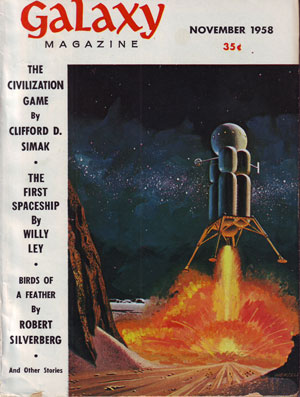The Sputnik non-surpriseby Dwayne Day
|
| If you were interested in space topics—not science fiction—in the late 1950s and early 1960s, you picked up Galaxy or another magazine with articles by Ley. |
Previously, I wrote about how, on the eve of the Sputnik launch in 1957, Ley wrote about the “space race” and mentioned nothing about the impending Soviet launch. (See: “The Sputnik Singularity”, The Space Review, October 20, 2008) This was not really his fault. Because of publication schedules, Ley often wrote his articles many months before they appeared in print. But recently I came across the November 1958 issue of Galaxy where Ley wrote a column about three subjects. The first was a discussion of Hermann Ganswindt, whom Ley believed had made the first attempt to describe a realistic (if hideously ugly) spaceship design. The second was a discussion of elliptical orbits.
Ley’s third subject was prompted by a discussion he had with some ham radio operators who had informed him that their Japanese counterparts had been tipped off about the impending launch of Sputnik by the Soviets. This prompted Ley to wonder just how much of a “surprise” Sputnik had actually been.
Ley did a media search to try and determine how widely the Soviet plans for launching a satellite were reported before the event. This must have taken him no more than a day in a decent library to find what he was looking for. He quickly found several references:
Aviation Week, October 31, 1955, contained a full-page article about another article written by Professor Kyrill Stanyukovitch. Stanyukovitch’s article was mostly about Vanguard, but ended with a statement that “Russian engineers believe that it is possible to build larger satellites than those being discussed now in the Western Press.”
Aviation Week, October 29, 1956, contained an article about a Moscow News article by Professor Georgi Pokrovsky stating that the Russian satellite would have a diameter of 24 inches [61 cenimeters], a weight of about 100 pounds [45 kilograms], and an orbit of 185 miles by 810 miles [300 by 1,300 kilometers]. As Ley noted, the actual values of Sputnik 1 were 23.8 inches [60.5 cm], 184 pounds [83.4 kilograms], and 156 by 560 miles [251 by 901 kilometers]. Pretty close.
The New York Times, June 2, 1957, reported on a Pravda article by Professor Alexander Nesmenyanov, president of the Soviet Academy of Sciences, who stated “We have created the rockets and all the equipment and instruments necessary to solve the problem of the artificial earth satellite.”
The New York Times, June 9, 1957, contained an article about a Literaturnaya Gazyeta article on Russian “space dogs” trained for rocket and satellite flights.
The New York Times, June 20, 1957, included an interview with several Russian scientists who predicted “several” Soviet satellites for the International Geophysical Year.
Aviation Week, July 29, 1959, reported on a three-day symposium of the Royal Aeronautical Society, where Milton Rosen reported on the American Vanguard program and Professor Boris Petrov stated that Russian satellites would be launched at a highly inclined angle to the equator. Petrov had provided the same information to the IGY headquarters in Belgium in June, and that information had been widely reported in newspapers at that time.
Reuter’s News Service, August 3, 1957, reported that Professor Evgenii Fyedorov had been officially named head of the Russian satellite program and that he was quoted providing some information about an upcoming Russian satellite, saying that it would be launched at dawn atop a three-stage rocket and have a 90-minute orbit around the Earth. (In fact, Fyedorov’s comments had not escaped the notice of the CIA, which postulated that they could be an indication that the Soviets were attempting to beat the United States into space.)
| An American satellite would not have surprised the West, and in fact would not have surprised the Soviets, because the Americans were expected to accomplish amazing technological feats. |
Ley’s point was that anybody paying attention had ample warning that the Soviets were about to launch a satellite and should not have been surprised. Impressed, certainly, but not surprised. Of course, in truth there is also fiction, and the sources that Ley cited also create an impression of a Soviet space program that was science-driven and run by academics, which we now know was not true.
The world was still shocked by Sputnik on October 4, 1957, and would have been even if the Soviets had been totally open and forthright about it on October 3. The reason was not so much the accomplishment itself as the fact that it was done by a country that was widely regarded as agrarian and technologically backward. An American satellite would not have surprised the West, and in fact would not have surprised the Soviets, because the Americans were expected to accomplish amazing technological feats, like blowing up H-bombs and building jetliners. The Soviets were dirt farmers—and nobody paid attention to those dirt farmers until they launched a shiny little ball that shook the world.
